Negligent Misstatement: L Shaddock v Parramatta City Council (1982)
VerifiedAdded on 2020/04/01
|10
|2443
|42
Case Study
AI Summary
This case study analyzes the landmark case of L Shaddock v Parramatta City Council (1982), focusing on the legal principles of negligent misstatement and the duty of care. The case involves a property developer, Shaddock & Associates, who sought information from the Parramatta City Council regarding potential road widening proposals affecting a property they intended to purchase. The council provided inaccurate information, leading to financial losses for Shaddock. The High Court of Australia ultimately found the council liable, establishing that public authorities owe a duty of care when providing information, extending this duty beyond simply providing advice. The analysis examines the facts, issues raised, arguments of both parties, the judgments of the trial judge, the New South Wales Court of Appeal, and the High Court. The court's reasoning and critical analysis are provided, focusing on the scope of the duty of care and the implications of negligent misstatements by public bodies. The case highlights the importance of accurate information and the potential liability of authorities for providing it.
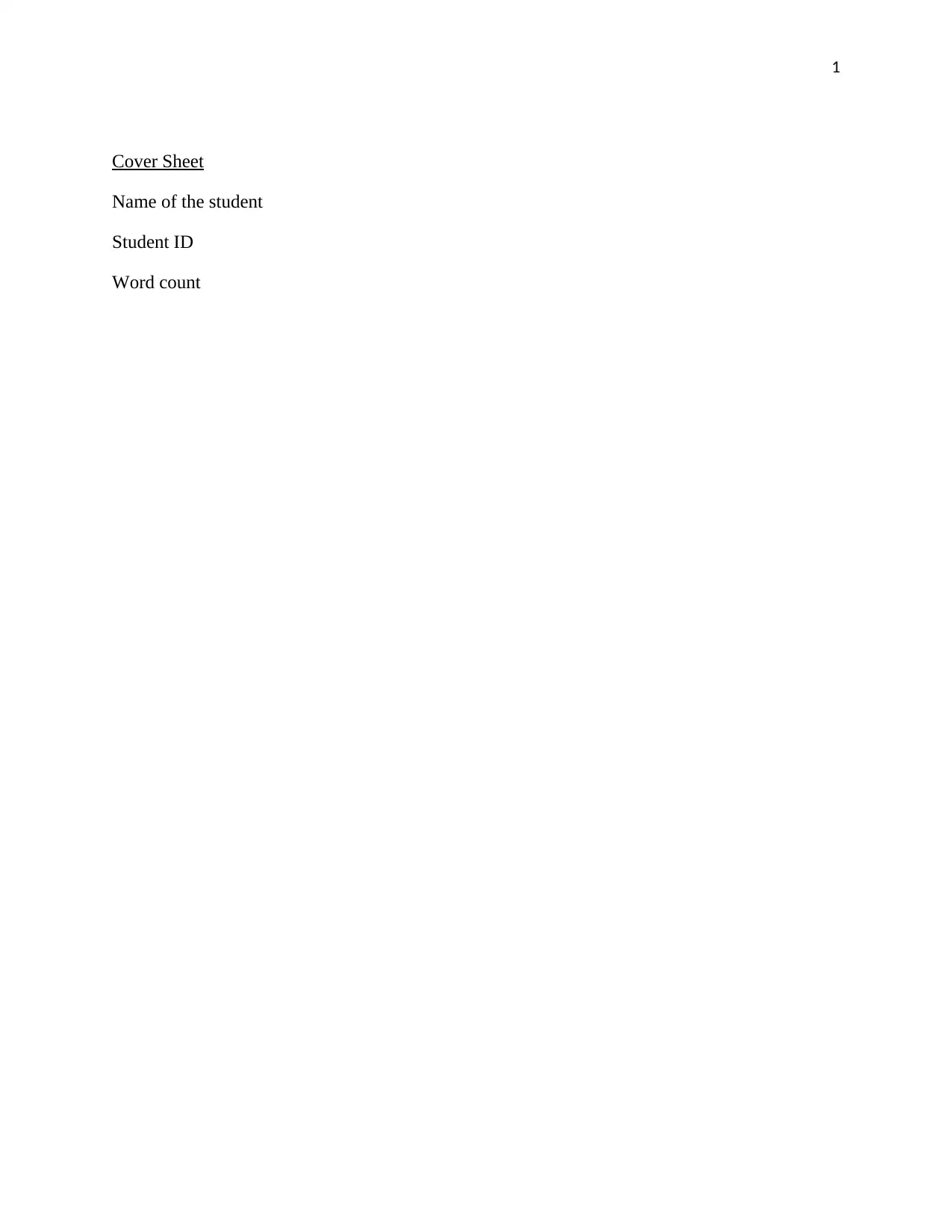
1
Cover Sheet
Name of the student
Student ID
Word count
Cover Sheet
Name of the student
Student ID
Word count
Paraphrase This Document
Need a fresh take? Get an instant paraphrase of this document with our AI Paraphraser
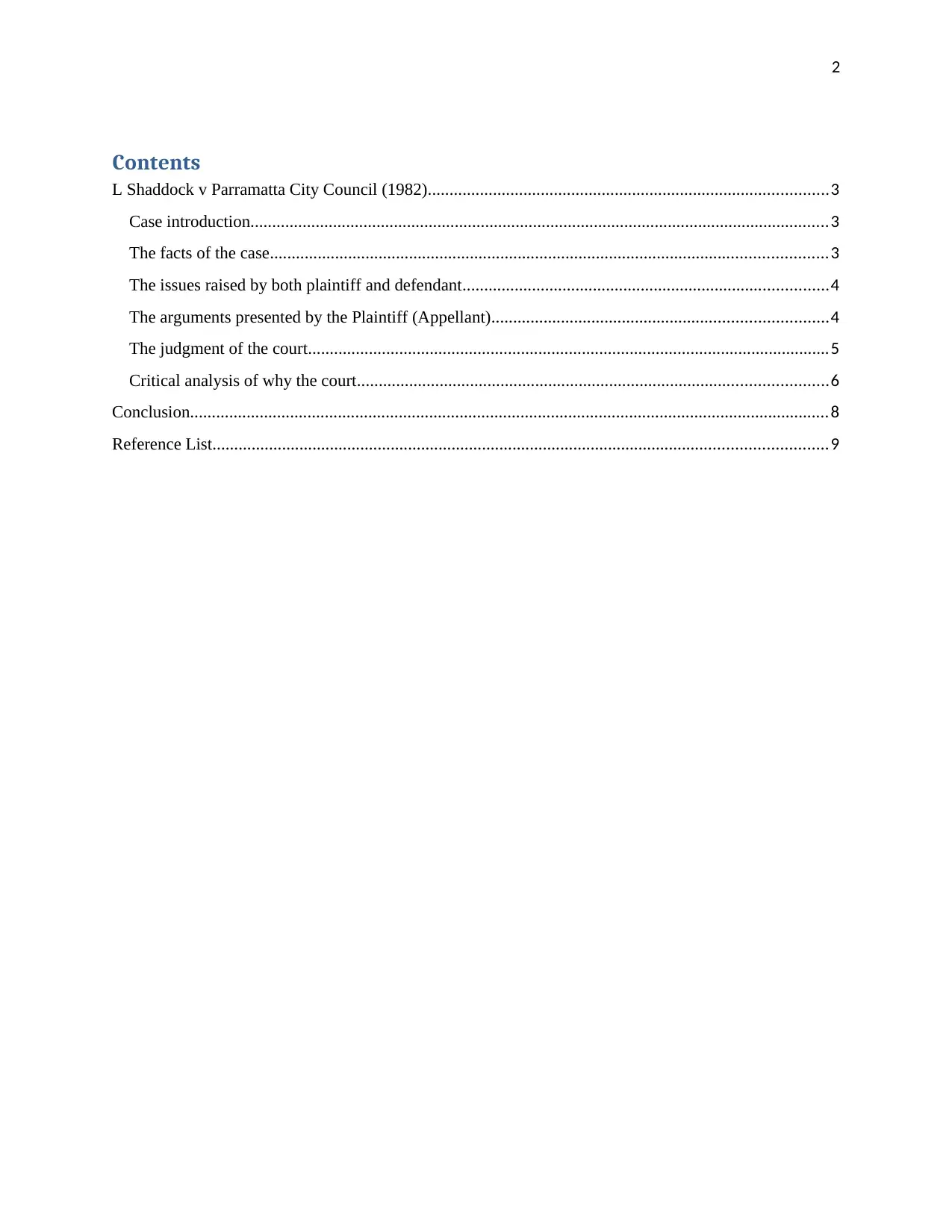
2
Contents
L Shaddock v Parramatta City Council (1982)............................................................................................3
Case introduction.....................................................................................................................................3
The facts of the case................................................................................................................................3
The issues raised by both plaintiff and defendant....................................................................................4
The arguments presented by the Plaintiff (Appellant).............................................................................4
The judgment of the court........................................................................................................................5
Critical analysis of why the court............................................................................................................6
Conclusion...................................................................................................................................................8
Reference List.............................................................................................................................................9
Contents
L Shaddock v Parramatta City Council (1982)............................................................................................3
Case introduction.....................................................................................................................................3
The facts of the case................................................................................................................................3
The issues raised by both plaintiff and defendant....................................................................................4
The arguments presented by the Plaintiff (Appellant).............................................................................4
The judgment of the court........................................................................................................................5
Critical analysis of why the court............................................................................................................6
Conclusion...................................................................................................................................................8
Reference List.............................................................................................................................................9
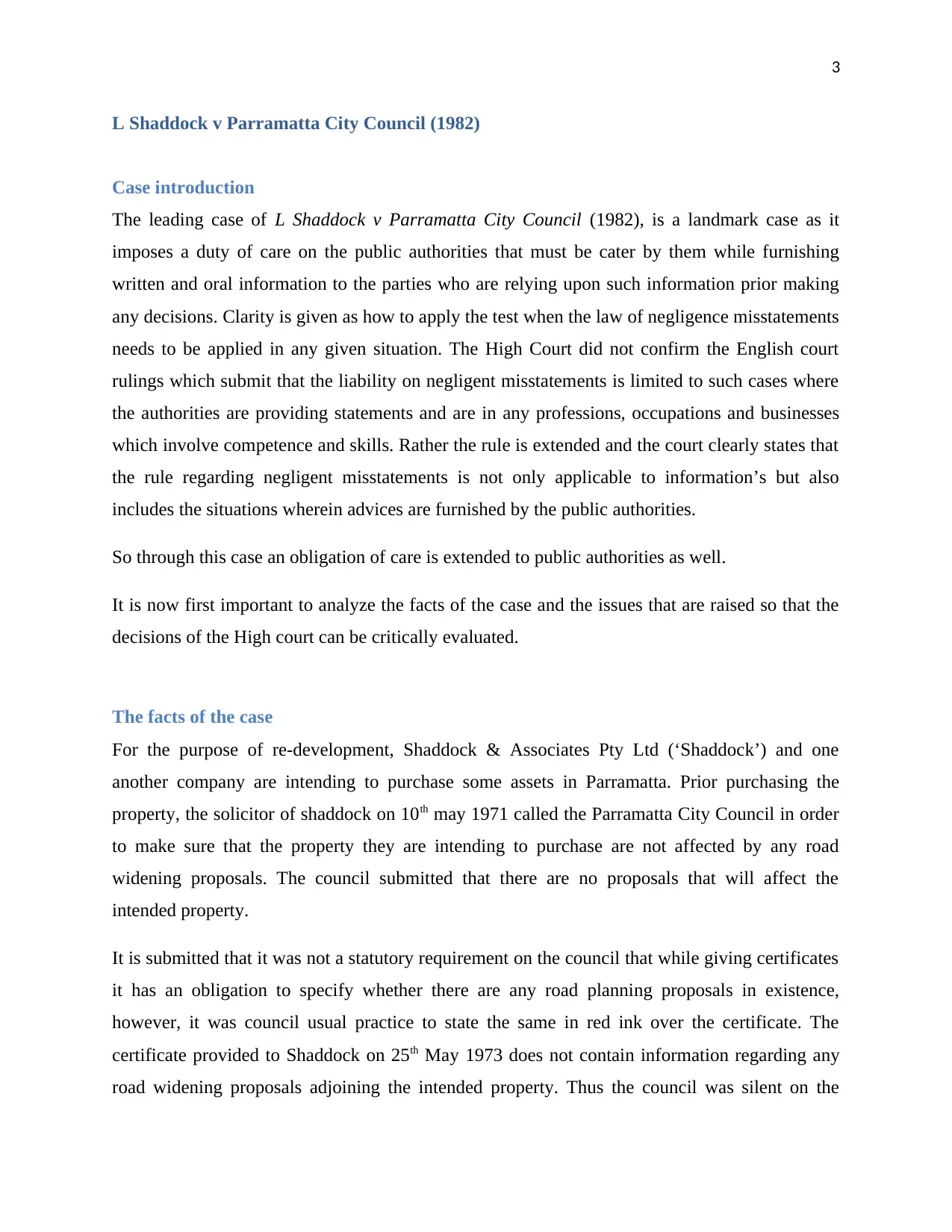
3
L Shaddock v Parramatta City Council (1982)
Case introduction
The leading case of L Shaddock v Parramatta City Council (1982), is a landmark case as it
imposes a duty of care on the public authorities that must be cater by them while furnishing
written and oral information to the parties who are relying upon such information prior making
any decisions. Clarity is given as how to apply the test when the law of negligence misstatements
needs to be applied in any given situation. The High Court did not confirm the English court
rulings which submit that the liability on negligent misstatements is limited to such cases where
the authorities are providing statements and are in any professions, occupations and businesses
which involve competence and skills. Rather the rule is extended and the court clearly states that
the rule regarding negligent misstatements is not only applicable to information’s but also
includes the situations wherein advices are furnished by the public authorities.
So through this case an obligation of care is extended to public authorities as well.
It is now first important to analyze the facts of the case and the issues that are raised so that the
decisions of the High court can be critically evaluated.
The facts of the case
For the purpose of re-development, Shaddock & Associates Pty Ltd (‘Shaddock’) and one
another company are intending to purchase some assets in Parramatta. Prior purchasing the
property, the solicitor of shaddock on 10th may 1971 called the Parramatta City Council in order
to make sure that the property they are intending to purchase are not affected by any road
widening proposals. The council submitted that there are no proposals that will affect the
intended property.
It is submitted that it was not a statutory requirement on the council that while giving certificates
it has an obligation to specify whether there are any road planning proposals in existence,
however, it was council usual practice to state the same in red ink over the certificate. The
certificate provided to Shaddock on 25th May 1973 does not contain information regarding any
road widening proposals adjoining the intended property. Thus the council was silent on the
L Shaddock v Parramatta City Council (1982)
Case introduction
The leading case of L Shaddock v Parramatta City Council (1982), is a landmark case as it
imposes a duty of care on the public authorities that must be cater by them while furnishing
written and oral information to the parties who are relying upon such information prior making
any decisions. Clarity is given as how to apply the test when the law of negligence misstatements
needs to be applied in any given situation. The High Court did not confirm the English court
rulings which submit that the liability on negligent misstatements is limited to such cases where
the authorities are providing statements and are in any professions, occupations and businesses
which involve competence and skills. Rather the rule is extended and the court clearly states that
the rule regarding negligent misstatements is not only applicable to information’s but also
includes the situations wherein advices are furnished by the public authorities.
So through this case an obligation of care is extended to public authorities as well.
It is now first important to analyze the facts of the case and the issues that are raised so that the
decisions of the High court can be critically evaluated.
The facts of the case
For the purpose of re-development, Shaddock & Associates Pty Ltd (‘Shaddock’) and one
another company are intending to purchase some assets in Parramatta. Prior purchasing the
property, the solicitor of shaddock on 10th may 1971 called the Parramatta City Council in order
to make sure that the property they are intending to purchase are not affected by any road
widening proposals. The council submitted that there are no proposals that will affect the
intended property.
It is submitted that it was not a statutory requirement on the council that while giving certificates
it has an obligation to specify whether there are any road planning proposals in existence,
however, it was council usual practice to state the same in red ink over the certificate. The
certificate provided to Shaddock on 25th May 1973 does not contain information regarding any
road widening proposals adjoining the intended property. Thus the council was silent on the
⊘ This is a preview!⊘
Do you want full access?
Subscribe today to unlock all pages.

Trusted by 1+ million students worldwide
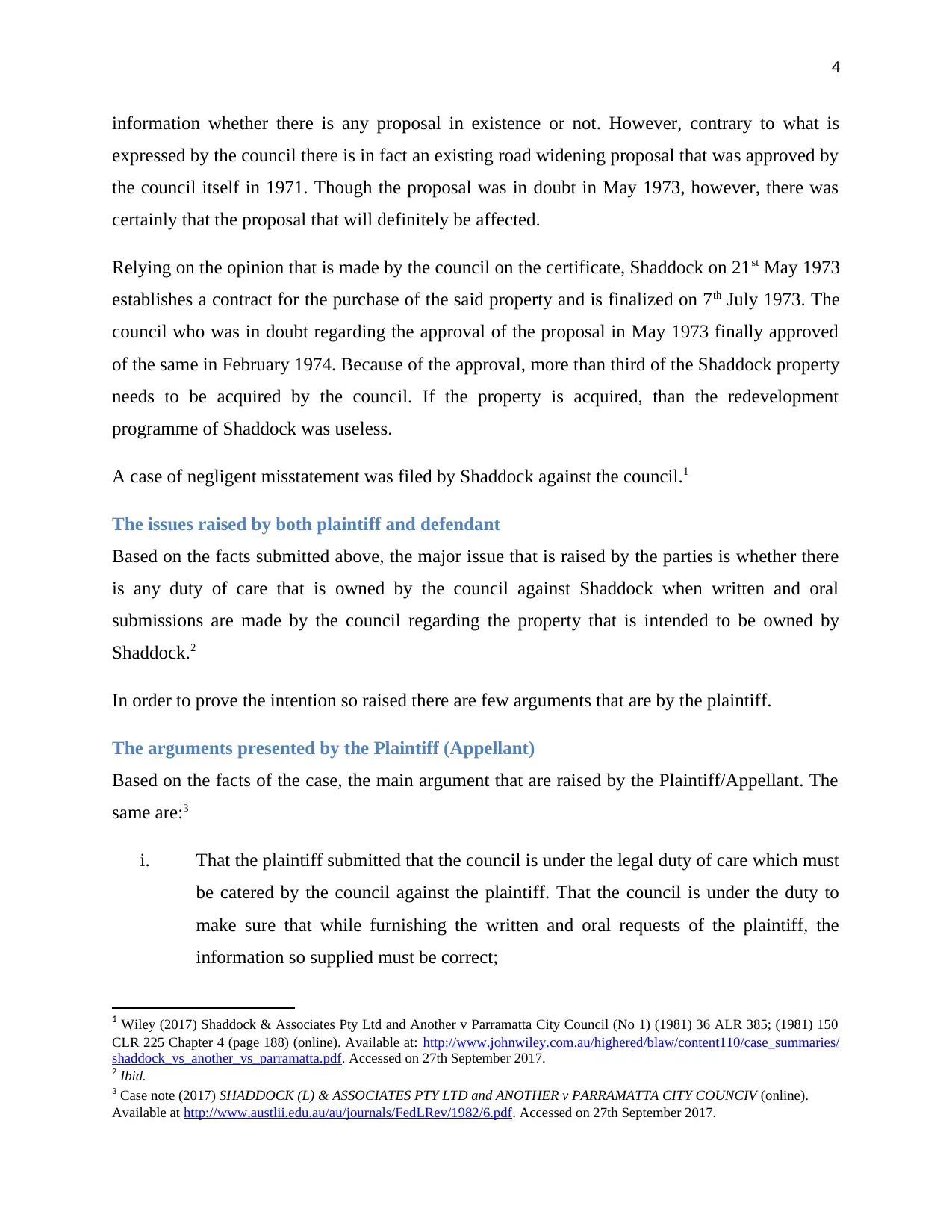
4
information whether there is any proposal in existence or not. However, contrary to what is
expressed by the council there is in fact an existing road widening proposal that was approved by
the council itself in 1971. Though the proposal was in doubt in May 1973, however, there was
certainly that the proposal that will definitely be affected.
Relying on the opinion that is made by the council on the certificate, Shaddock on 21st May 1973
establishes a contract for the purchase of the said property and is finalized on 7th July 1973. The
council who was in doubt regarding the approval of the proposal in May 1973 finally approved
of the same in February 1974. Because of the approval, more than third of the Shaddock property
needs to be acquired by the council. If the property is acquired, than the redevelopment
programme of Shaddock was useless.
A case of negligent misstatement was filed by Shaddock against the council.1
The issues raised by both plaintiff and defendant
Based on the facts submitted above, the major issue that is raised by the parties is whether there
is any duty of care that is owned by the council against Shaddock when written and oral
submissions are made by the council regarding the property that is intended to be owned by
Shaddock.2
In order to prove the intention so raised there are few arguments that are by the plaintiff.
The arguments presented by the Plaintiff (Appellant)
Based on the facts of the case, the main argument that are raised by the Plaintiff/Appellant. The
same are:3
i. That the plaintiff submitted that the council is under the legal duty of care which must
be catered by the council against the plaintiff. That the council is under the duty to
make sure that while furnishing the written and oral requests of the plaintiff, the
information so supplied must be correct;
1 Wiley (2017) Shaddock & Associates Pty Ltd and Another v Parramatta City Council (No 1) (1981) 36 ALR 385; (1981) 150
CLR 225 Chapter 4 (page 188) (online). Available at: http://www.johnwiley.com.au/highered/blaw/content110/case_summaries/
shaddock_vs_another_vs_parramatta.pdf. Accessed on 27th September 2017.
2 Ibid.
3 Case note (2017) SHADDOCK (L) & ASSOCIATES PTY LTD and ANOTHER v PARRAMATTA CITY COUNCIV (online).
Available at http://www.austlii.edu.au/au/journals/FedLRev/1982/6.pdf. Accessed on 27th September 2017.
information whether there is any proposal in existence or not. However, contrary to what is
expressed by the council there is in fact an existing road widening proposal that was approved by
the council itself in 1971. Though the proposal was in doubt in May 1973, however, there was
certainly that the proposal that will definitely be affected.
Relying on the opinion that is made by the council on the certificate, Shaddock on 21st May 1973
establishes a contract for the purchase of the said property and is finalized on 7th July 1973. The
council who was in doubt regarding the approval of the proposal in May 1973 finally approved
of the same in February 1974. Because of the approval, more than third of the Shaddock property
needs to be acquired by the council. If the property is acquired, than the redevelopment
programme of Shaddock was useless.
A case of negligent misstatement was filed by Shaddock against the council.1
The issues raised by both plaintiff and defendant
Based on the facts submitted above, the major issue that is raised by the parties is whether there
is any duty of care that is owned by the council against Shaddock when written and oral
submissions are made by the council regarding the property that is intended to be owned by
Shaddock.2
In order to prove the intention so raised there are few arguments that are by the plaintiff.
The arguments presented by the Plaintiff (Appellant)
Based on the facts of the case, the main argument that are raised by the Plaintiff/Appellant. The
same are:3
i. That the plaintiff submitted that the council is under the legal duty of care which must
be catered by the council against the plaintiff. That the council is under the duty to
make sure that while furnishing the written and oral requests of the plaintiff, the
information so supplied must be correct;
1 Wiley (2017) Shaddock & Associates Pty Ltd and Another v Parramatta City Council (No 1) (1981) 36 ALR 385; (1981) 150
CLR 225 Chapter 4 (page 188) (online). Available at: http://www.johnwiley.com.au/highered/blaw/content110/case_summaries/
shaddock_vs_another_vs_parramatta.pdf. Accessed on 27th September 2017.
2 Ibid.
3 Case note (2017) SHADDOCK (L) & ASSOCIATES PTY LTD and ANOTHER v PARRAMATTA CITY COUNCIV (online).
Available at http://www.austlii.edu.au/au/journals/FedLRev/1982/6.pdf. Accessed on 27th September 2017.
Paraphrase This Document
Need a fresh take? Get an instant paraphrase of this document with our AI Paraphraser
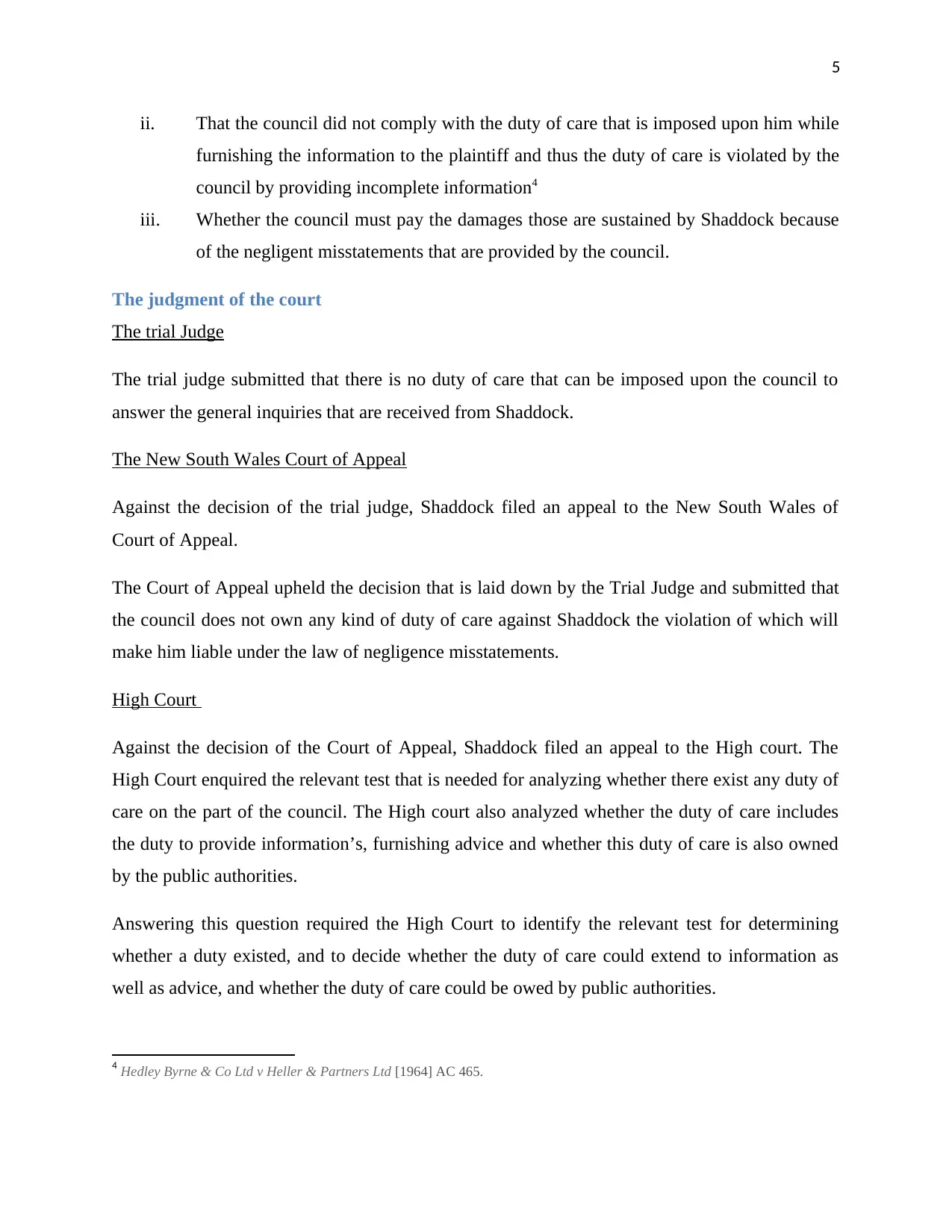
5
ii. That the council did not comply with the duty of care that is imposed upon him while
furnishing the information to the plaintiff and thus the duty of care is violated by the
council by providing incomplete information4
iii. Whether the council must pay the damages those are sustained by Shaddock because
of the negligent misstatements that are provided by the council.
The judgment of the court
The trial Judge
The trial judge submitted that there is no duty of care that can be imposed upon the council to
answer the general inquiries that are received from Shaddock.
The New South Wales Court of Appeal
Against the decision of the trial judge, Shaddock filed an appeal to the New South Wales of
Court of Appeal.
The Court of Appeal upheld the decision that is laid down by the Trial Judge and submitted that
the council does not own any kind of duty of care against Shaddock the violation of which will
make him liable under the law of negligence misstatements.
High Court
Against the decision of the Court of Appeal, Shaddock filed an appeal to the High court. The
High Court enquired the relevant test that is needed for analyzing whether there exist any duty of
care on the part of the council. The High court also analyzed whether the duty of care includes
the duty to provide information’s, furnishing advice and whether this duty of care is also owned
by the public authorities.
Answering this question required the High Court to identify the relevant test for determining
whether a duty existed, and to decide whether the duty of care could extend to information as
well as advice, and whether the duty of care could be owed by public authorities.
4 Hedley Byrne & Co Ltd v Heller & Partners Ltd [1964] AC 465.
ii. That the council did not comply with the duty of care that is imposed upon him while
furnishing the information to the plaintiff and thus the duty of care is violated by the
council by providing incomplete information4
iii. Whether the council must pay the damages those are sustained by Shaddock because
of the negligent misstatements that are provided by the council.
The judgment of the court
The trial Judge
The trial judge submitted that there is no duty of care that can be imposed upon the council to
answer the general inquiries that are received from Shaddock.
The New South Wales Court of Appeal
Against the decision of the trial judge, Shaddock filed an appeal to the New South Wales of
Court of Appeal.
The Court of Appeal upheld the decision that is laid down by the Trial Judge and submitted that
the council does not own any kind of duty of care against Shaddock the violation of which will
make him liable under the law of negligence misstatements.
High Court
Against the decision of the Court of Appeal, Shaddock filed an appeal to the High court. The
High Court enquired the relevant test that is needed for analyzing whether there exist any duty of
care on the part of the council. The High court also analyzed whether the duty of care includes
the duty to provide information’s, furnishing advice and whether this duty of care is also owned
by the public authorities.
Answering this question required the High Court to identify the relevant test for determining
whether a duty existed, and to decide whether the duty of care could extend to information as
well as advice, and whether the duty of care could be owed by public authorities.
4 Hedley Byrne & Co Ltd v Heller & Partners Ltd [1964] AC 465.
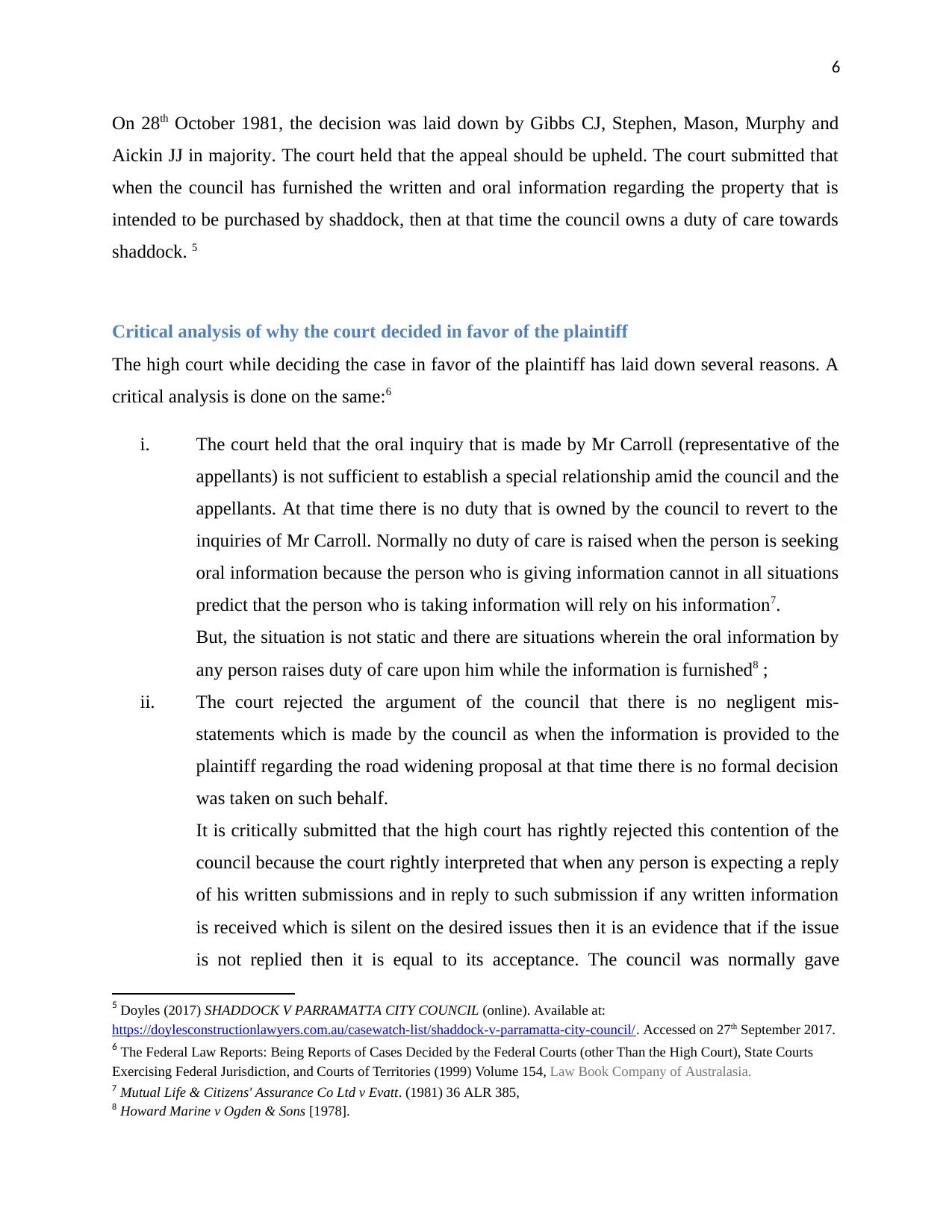
6
On 28th October 1981, the decision was laid down by Gibbs CJ, Stephen, Mason, Murphy and
Aickin JJ in majority. The court held that the appeal should be upheld. The court submitted that
when the council has furnished the written and oral information regarding the property that is
intended to be purchased by shaddock, then at that time the council owns a duty of care towards
shaddock. 5
Critical analysis of why the court decided in favor of the plaintiff
The high court while deciding the case in favor of the plaintiff has laid down several reasons. A
critical analysis is done on the same:6
i. The court held that the oral inquiry that is made by Mr Carroll (representative of the
appellants) is not sufficient to establish a special relationship amid the council and the
appellants. At that time there is no duty that is owned by the council to revert to the
inquiries of Mr Carroll. Normally no duty of care is raised when the person is seeking
oral information because the person who is giving information cannot in all situations
predict that the person who is taking information will rely on his information7.
But, the situation is not static and there are situations wherein the oral information by
any person raises duty of care upon him while the information is furnished8 ;
ii. The court rejected the argument of the council that there is no negligent mis-
statements which is made by the council as when the information is provided to the
plaintiff regarding the road widening proposal at that time there is no formal decision
was taken on such behalf.
It is critically submitted that the high court has rightly rejected this contention of the
council because the court rightly interpreted that when any person is expecting a reply
of his written submissions and in reply to such submission if any written information
is received which is silent on the desired issues then it is an evidence that if the issue
is not replied then it is equal to its acceptance. The council was normally gave
5 Doyles (2017) SHADDOCK V PARRAMATTA CITY COUNCIL (online). Available at:
https://doylesconstructionlawyers.com.au/casewatch-list/shaddock-v-parramatta-city-council/. Accessed on 27th September 2017.
6 The Federal Law Reports: Being Reports of Cases Decided by the Federal Courts (other Than the High Court), State Courts
Exercising Federal Jurisdiction, and Courts of Territories (1999) Volume 154, Law Book Company of Australasia.
7 Mutual Life & Citizens' Assurance Co Ltd v Evatt. (1981) 36 ALR 385,
8 Howard Marine v Ogden & Sons [1978].
On 28th October 1981, the decision was laid down by Gibbs CJ, Stephen, Mason, Murphy and
Aickin JJ in majority. The court held that the appeal should be upheld. The court submitted that
when the council has furnished the written and oral information regarding the property that is
intended to be purchased by shaddock, then at that time the council owns a duty of care towards
shaddock. 5
Critical analysis of why the court decided in favor of the plaintiff
The high court while deciding the case in favor of the plaintiff has laid down several reasons. A
critical analysis is done on the same:6
i. The court held that the oral inquiry that is made by Mr Carroll (representative of the
appellants) is not sufficient to establish a special relationship amid the council and the
appellants. At that time there is no duty that is owned by the council to revert to the
inquiries of Mr Carroll. Normally no duty of care is raised when the person is seeking
oral information because the person who is giving information cannot in all situations
predict that the person who is taking information will rely on his information7.
But, the situation is not static and there are situations wherein the oral information by
any person raises duty of care upon him while the information is furnished8 ;
ii. The court rejected the argument of the council that there is no negligent mis-
statements which is made by the council as when the information is provided to the
plaintiff regarding the road widening proposal at that time there is no formal decision
was taken on such behalf.
It is critically submitted that the high court has rightly rejected this contention of the
council because the court rightly interpreted that when any person is expecting a reply
of his written submissions and in reply to such submission if any written information
is received which is silent on the desired issues then it is an evidence that if the issue
is not replied then it is equal to its acceptance. The council was normally gave
5 Doyles (2017) SHADDOCK V PARRAMATTA CITY COUNCIL (online). Available at:
https://doylesconstructionlawyers.com.au/casewatch-list/shaddock-v-parramatta-city-council/. Accessed on 27th September 2017.
6 The Federal Law Reports: Being Reports of Cases Decided by the Federal Courts (other Than the High Court), State Courts
Exercising Federal Jurisdiction, and Courts of Territories (1999) Volume 154, Law Book Company of Australasia.
7 Mutual Life & Citizens' Assurance Co Ltd v Evatt. (1981) 36 ALR 385,
8 Howard Marine v Ogden & Sons [1978].
⊘ This is a preview!⊘
Do you want full access?
Subscribe today to unlock all pages.

Trusted by 1+ million students worldwide
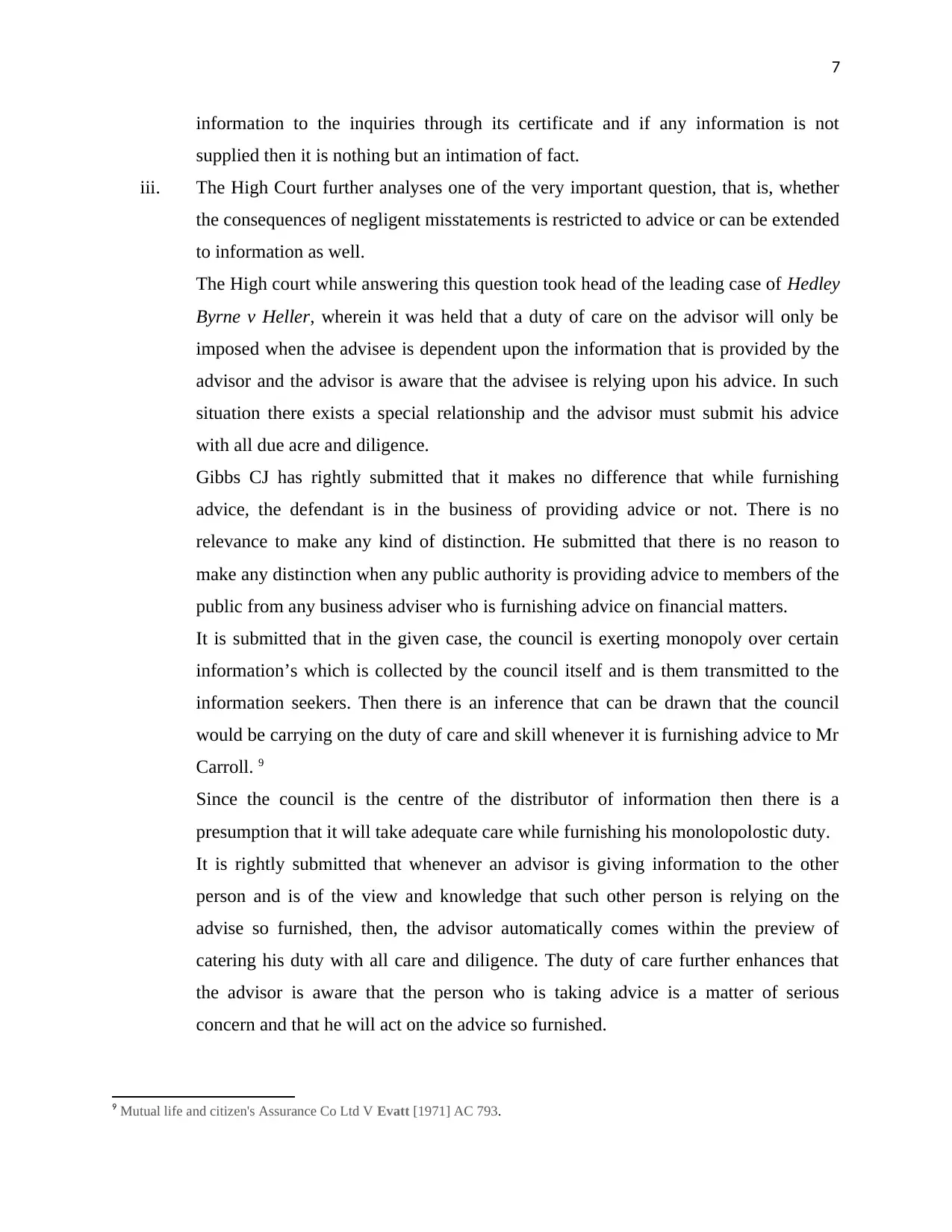
7
information to the inquiries through its certificate and if any information is not
supplied then it is nothing but an intimation of fact.
iii. The High Court further analyses one of the very important question, that is, whether
the consequences of negligent misstatements is restricted to advice or can be extended
to information as well.
The High court while answering this question took head of the leading case of Hedley
Byrne v Heller, wherein it was held that a duty of care on the advisor will only be
imposed when the advisee is dependent upon the information that is provided by the
advisor and the advisor is aware that the advisee is relying upon his advice. In such
situation there exists a special relationship and the advisor must submit his advice
with all due acre and diligence.
Gibbs CJ has rightly submitted that it makes no difference that while furnishing
advice, the defendant is in the business of providing advice or not. There is no
relevance to make any kind of distinction. He submitted that there is no reason to
make any distinction when any public authority is providing advice to members of the
public from any business adviser who is furnishing advice on financial matters.
It is submitted that in the given case, the council is exerting monopoly over certain
information’s which is collected by the council itself and is them transmitted to the
information seekers. Then there is an inference that can be drawn that the council
would be carrying on the duty of care and skill whenever it is furnishing advice to Mr
Carroll. 9
Since the council is the centre of the distributor of information then there is a
presumption that it will take adequate care while furnishing his monolopolostic duty.
It is rightly submitted that whenever an advisor is giving information to the other
person and is of the view and knowledge that such other person is relying on the
advise so furnished, then, the advisor automatically comes within the preview of
catering his duty with all care and diligence. The duty of care further enhances that
the advisor is aware that the person who is taking advice is a matter of serious
concern and that he will act on the advice so furnished.
9 Mutual life and citizen's Assurance Co Ltd V Evatt [1971] AC 793.
information to the inquiries through its certificate and if any information is not
supplied then it is nothing but an intimation of fact.
iii. The High Court further analyses one of the very important question, that is, whether
the consequences of negligent misstatements is restricted to advice or can be extended
to information as well.
The High court while answering this question took head of the leading case of Hedley
Byrne v Heller, wherein it was held that a duty of care on the advisor will only be
imposed when the advisee is dependent upon the information that is provided by the
advisor and the advisor is aware that the advisee is relying upon his advice. In such
situation there exists a special relationship and the advisor must submit his advice
with all due acre and diligence.
Gibbs CJ has rightly submitted that it makes no difference that while furnishing
advice, the defendant is in the business of providing advice or not. There is no
relevance to make any kind of distinction. He submitted that there is no reason to
make any distinction when any public authority is providing advice to members of the
public from any business adviser who is furnishing advice on financial matters.
It is submitted that in the given case, the council is exerting monopoly over certain
information’s which is collected by the council itself and is them transmitted to the
information seekers. Then there is an inference that can be drawn that the council
would be carrying on the duty of care and skill whenever it is furnishing advice to Mr
Carroll. 9
Since the council is the centre of the distributor of information then there is a
presumption that it will take adequate care while furnishing his monolopolostic duty.
It is rightly submitted that whenever an advisor is giving information to the other
person and is of the view and knowledge that such other person is relying on the
advise so furnished, then, the advisor automatically comes within the preview of
catering his duty with all care and diligence. The duty of care further enhances that
the advisor is aware that the person who is taking advice is a matter of serious
concern and that he will act on the advice so furnished.
9 Mutual life and citizen's Assurance Co Ltd V Evatt [1971] AC 793.
Paraphrase This Document
Need a fresh take? Get an instant paraphrase of this document with our AI Paraphraser
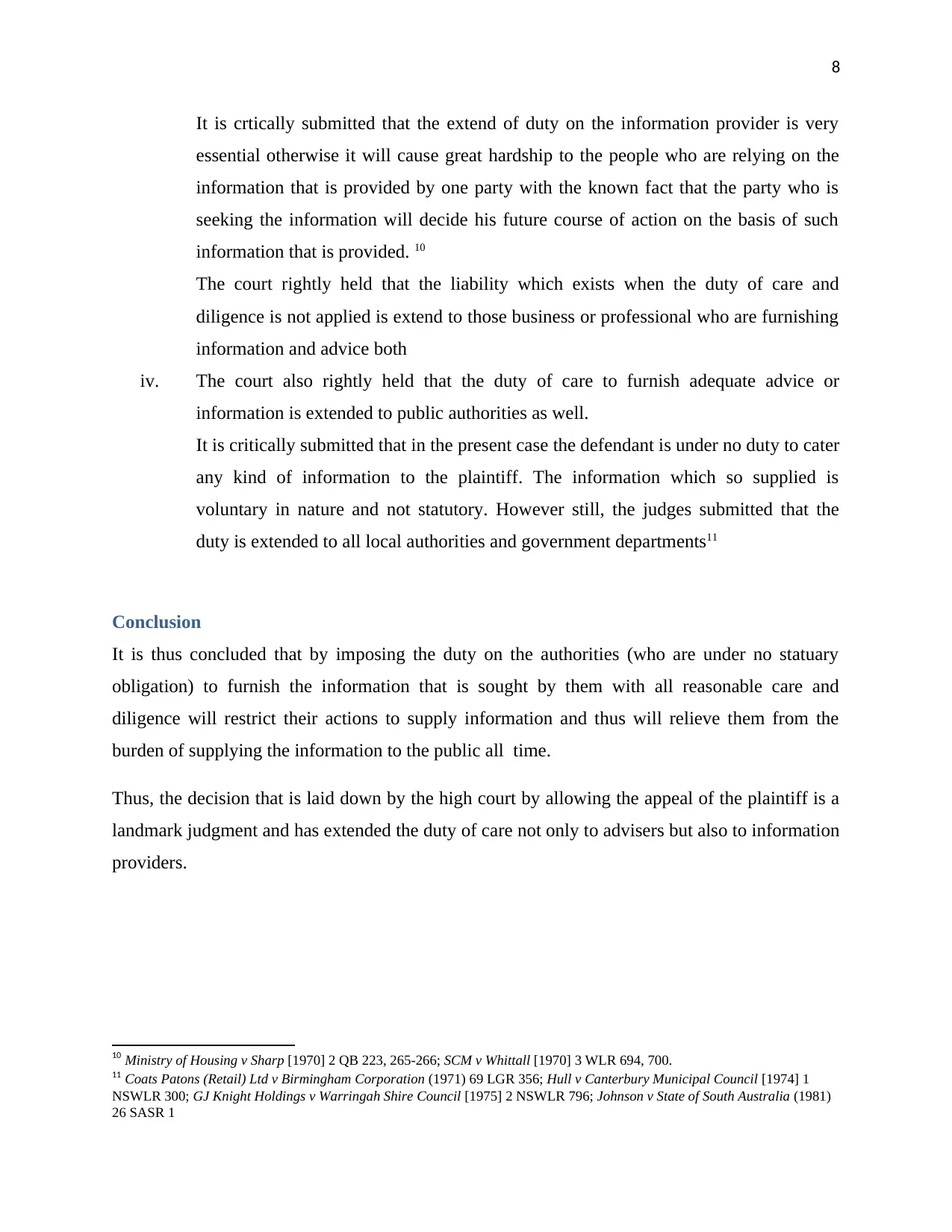
8
It is crtically submitted that the extend of duty on the information provider is very
essential otherwise it will cause great hardship to the people who are relying on the
information that is provided by one party with the known fact that the party who is
seeking the information will decide his future course of action on the basis of such
information that is provided. 10
The court rightly held that the liability which exists when the duty of care and
diligence is not applied is extend to those business or professional who are furnishing
information and advice both
iv. The court also rightly held that the duty of care to furnish adequate advice or
information is extended to public authorities as well.
It is critically submitted that in the present case the defendant is under no duty to cater
any kind of information to the plaintiff. The information which so supplied is
voluntary in nature and not statutory. However still, the judges submitted that the
duty is extended to all local authorities and government departments11
Conclusion
It is thus concluded that by imposing the duty on the authorities (who are under no statuary
obligation) to furnish the information that is sought by them with all reasonable care and
diligence will restrict their actions to supply information and thus will relieve them from the
burden of supplying the information to the public all time.
Thus, the decision that is laid down by the high court by allowing the appeal of the plaintiff is a
landmark judgment and has extended the duty of care not only to advisers but also to information
providers.
10 Ministry of Housing v Sharp [1970] 2 QB 223, 265-266; SCM v Whittall [1970] 3 WLR 694, 700.
11 Coats Patons (Retail) Ltd v Birmingham Corporation (1971) 69 LGR 356; Hull v Canterbury Municipal Council [1974] 1
NSWLR 300; GJ Knight Holdings v Warringah Shire Council [1975] 2 NSWLR 796; Johnson v State of South Australia (1981)
26 SASR 1
It is crtically submitted that the extend of duty on the information provider is very
essential otherwise it will cause great hardship to the people who are relying on the
information that is provided by one party with the known fact that the party who is
seeking the information will decide his future course of action on the basis of such
information that is provided. 10
The court rightly held that the liability which exists when the duty of care and
diligence is not applied is extend to those business or professional who are furnishing
information and advice both
iv. The court also rightly held that the duty of care to furnish adequate advice or
information is extended to public authorities as well.
It is critically submitted that in the present case the defendant is under no duty to cater
any kind of information to the plaintiff. The information which so supplied is
voluntary in nature and not statutory. However still, the judges submitted that the
duty is extended to all local authorities and government departments11
Conclusion
It is thus concluded that by imposing the duty on the authorities (who are under no statuary
obligation) to furnish the information that is sought by them with all reasonable care and
diligence will restrict their actions to supply information and thus will relieve them from the
burden of supplying the information to the public all time.
Thus, the decision that is laid down by the high court by allowing the appeal of the plaintiff is a
landmark judgment and has extended the duty of care not only to advisers but also to information
providers.
10 Ministry of Housing v Sharp [1970] 2 QB 223, 265-266; SCM v Whittall [1970] 3 WLR 694, 700.
11 Coats Patons (Retail) Ltd v Birmingham Corporation (1971) 69 LGR 356; Hull v Canterbury Municipal Council [1974] 1
NSWLR 300; GJ Knight Holdings v Warringah Shire Council [1975] 2 NSWLR 796; Johnson v State of South Australia (1981)
26 SASR 1

9
Reference List
Books/Articles/Journals
The Federal Law Reports: Being Reports of Cases Decided by the Federal Courts (other Than the
High Court), State Courts Exercising Federal Jurisdiction, and Courts of Territories (1999)
Volume 154, Law Book Company of Australasia
Case laws
Coats Patons (Retail) Ltd v Birmingham Corporation (1971) 69 LGR 356;
GJ Knight Holdings v Warringah Shire Council [1975] 2 NSWLR 796;
Hedley Byrne & Co Ltd v Heller & Partners Ltd [1964] AC 465.
Howard Marine v Ogden & Sons [1978].
Hull v Canterbury Municipal Council [1974] 1 NSWLR 300;
Johnson v State of South Australia (1981) 26 SASR 1
L Shaddock v Parramatta City Council (1982).
Mutual Life & Citizens' Assurance Co Ltd v Evatt. (1981) 36 ALR 385.
Ministry of Housing v Sharp [1970] 2 QB 223, 265-266;
SCM v Whittall [1970] 3 WLR 694, 700.
Online material
Case note (2017) SHADDOCK (L) & ASSOCIATES PTY LTD and ANOTHER v PARRAMATTA
CITY COUNCIV (online). Available at
http://www.austlii.edu.au/au/journals/FedLRev/1982/6.pdf. Accessed on 27th September 2017.
Doyles (2017) SHADDOCK V PARRAMATTA CITY COUNCIL (online). Available at:
https://doylesconstructionlawyers.com.au/casewatch-list/shaddock-v-parramatta-city-council/.
Accessed on 27th September 2017.
Reference List
Books/Articles/Journals
The Federal Law Reports: Being Reports of Cases Decided by the Federal Courts (other Than the
High Court), State Courts Exercising Federal Jurisdiction, and Courts of Territories (1999)
Volume 154, Law Book Company of Australasia
Case laws
Coats Patons (Retail) Ltd v Birmingham Corporation (1971) 69 LGR 356;
GJ Knight Holdings v Warringah Shire Council [1975] 2 NSWLR 796;
Hedley Byrne & Co Ltd v Heller & Partners Ltd [1964] AC 465.
Howard Marine v Ogden & Sons [1978].
Hull v Canterbury Municipal Council [1974] 1 NSWLR 300;
Johnson v State of South Australia (1981) 26 SASR 1
L Shaddock v Parramatta City Council (1982).
Mutual Life & Citizens' Assurance Co Ltd v Evatt. (1981) 36 ALR 385.
Ministry of Housing v Sharp [1970] 2 QB 223, 265-266;
SCM v Whittall [1970] 3 WLR 694, 700.
Online material
Case note (2017) SHADDOCK (L) & ASSOCIATES PTY LTD and ANOTHER v PARRAMATTA
CITY COUNCIV (online). Available at
http://www.austlii.edu.au/au/journals/FedLRev/1982/6.pdf. Accessed on 27th September 2017.
Doyles (2017) SHADDOCK V PARRAMATTA CITY COUNCIL (online). Available at:
https://doylesconstructionlawyers.com.au/casewatch-list/shaddock-v-parramatta-city-council/.
Accessed on 27th September 2017.
⊘ This is a preview!⊘
Do you want full access?
Subscribe today to unlock all pages.

Trusted by 1+ million students worldwide

10
Wiley (2017) Shaddock & Associates Pty Ltd and Another v Parramatta City Council (No 1)
(1981) 36 ALR 385; (1981) 150 CLR 225 Chapter 4 (page 188) (online). Available at:
http://www.johnwiley.com.au/highered/blaw/content110/case_summaries/
shaddock_vs_another_vs_parramatta.pdf. Accessed on 27th September 2017.
Wiley (2017) Shaddock & Associates Pty Ltd and Another v Parramatta City Council (No 1)
(1981) 36 ALR 385; (1981) 150 CLR 225 Chapter 4 (page 188) (online). Available at:
http://www.johnwiley.com.au/highered/blaw/content110/case_summaries/
shaddock_vs_another_vs_parramatta.pdf. Accessed on 27th September 2017.
1 out of 10
Related Documents
Your All-in-One AI-Powered Toolkit for Academic Success.
+13062052269
info@desklib.com
Available 24*7 on WhatsApp / Email
![[object Object]](/_next/static/media/star-bottom.7253800d.svg)
Unlock your academic potential
Copyright © 2020–2025 A2Z Services. All Rights Reserved. Developed and managed by ZUCOL.





